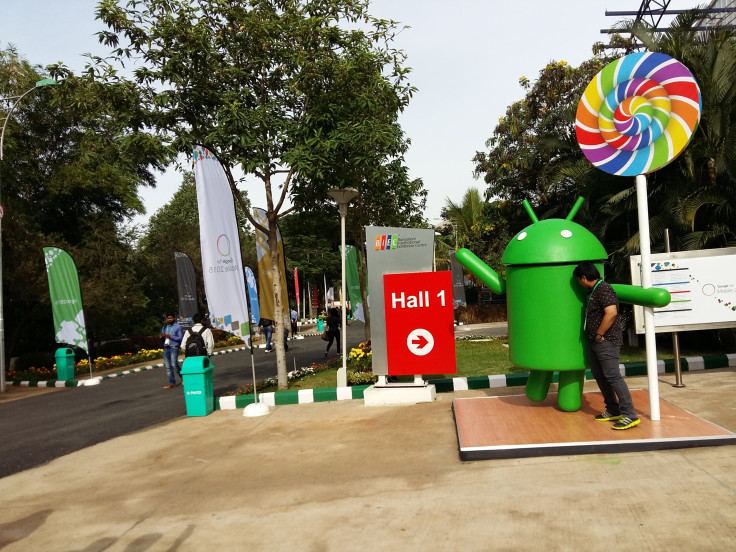Google Exhorts App Developers In India To Build For The Next Billion

BANGALORE, India -- Divya Garg, a 20-something software engineer at Flipkart, India's top online shopping company, was thrilled to find that her company's mobile app had the fifth-highest number of downloads in July in India, counting both Google Play and Apple Inc.'s app store.
The data came from App Annie, one of the foremost providers of analysis on mobile apps, and "I've even taken a photograph of the slide to show people back at the office," Garg beamed. Garg, who has recently trained in Android, was looking to hear more about the latest from Google itself, at the Internet search giant's program for developers in India -- Google For Mobile 2015.
"I'm here to find out more about their best practices ... looking forward to the next sessions for developers," she said.
Garg was one of many who attended the Google event, where the company wooed developers in India to take advantage of the coming mobile-led explosion in Internet access. India's growth as a smartphone market, which will bring the next billion online, makes it a market that developers must tap aggressively, Google's top executives dealing with developers worldwide said.
World On A Small Screen
Flipkart, which went app-only on mobile phones earlier this year, is an example of how the next generation of Internet users is going online. There were 7.4 billion connected devices on the planet in 2014, said Scott Sheffer, VP, publisher business solutions, Google. And "88 percent of the growth in connected devices came from mobile devices," said Sheffer, who has a global team of 350 people working with 2 million developers worldwide, from San Francisco to Bangalore to Beijing.
India is a growing part of the shift in the world's Internet user base, Sheffer said. In 1995, 61 percent of the world's Internet users were in the U.S. Today, that proportion is only 10 percent, with most of the rest coming from Asia Pacific, which accounts for 51 percent of the planet's Internet users.
Another factor that makes India, and other emerging markets, the regions that app developers must focus on is that 50 percent of the Internet users in India are between the age of 18 and 23. In Latin America, 47 percent are 24 years of age or below.
"The notion of 'going online' itself is going to fade away" and people will increasingly move to an "always connected" scenario and the younger they are, the more the likelihood that they will be connected using their smartphones, Sheffer said.
Already, experiments are underway the world over with new ways of using that connectivity -- a Ralph Lauren T-shirt that sends data on a workout directly to a smartphone, for instance -- and "the next billion user segment is certainly going to expect technology to do a lot more," Sheffer told developers at the conference.
Ad sales on mobile phones will also rise in the coming years, going from $70 billion in 2015 to $200 billion in 2018-2019, he said, citing industry estimates. In the U.S. alone, mobile devices accounted for a quarter of all the time people spent on different media, including newspapers, radio and television, and yet, mobile devices accounted for only 8 percent of the ad spend today. That left a $25 billion potential increase in spending on mobile ads in the U.S., he said.
However, India also poses a challenge for revenue generation for developers. While the country ranked in the top 5 on Google Play by downloads, it ranked 36 when it came to revenue from sales of apps on Google Play and Apple's iOS store combined, Junde Yu, vice president at App Annie, pointed out. Of the top 100 apps by downloads worldwide, not one was made in India. Most popular apps today are made either in the West or by Chinese and Japanese developers.
Offline Market
Markets such as India have their drawbacks too: Hardly anyone uses credit cards and most people still rely on older wireless connections and often have no real access to the Internet, even as urban consumers are leading a revolution in sub-$100 4G smartphone sales as Xiaomi and Lenovo Group compete against Samsung Electronics Co.
India is a market where 71 percent of mobile phone users still have only 2G wireless and a third of devices shipped have only 512MB of storage, said Sandeep Menon, Google's chief marketing officer in India. That means apps need to work on devices with limited storage capacity, and often flaky connectivity. If the app works offline -- something Google did with YouTube to a huge welcome in India -- nothing like it. Google is working hard to make other products such as Google Maps work offline, Menon said.
Access to the Internet in local languages -- consumption in Hindi is growing five times faster than in English -- and the higher cost of data -- the average data pack in India is six times as costly as in the U.S. -- are other challenges that developers must surmount, he said. By 2018, there will be more developers in India for Google than anywhere else in the world, he said.
© Copyright IBTimes 2025. All rights reserved.




















